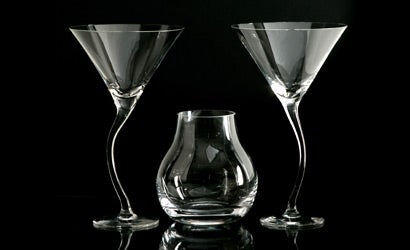Master Glass
To really learn studio lighting, shoot glass.

We may earn revenue from the products available on this page and participate in affiliate programs. Learn more ›
It’s almost a magician’s art: giving form to an object that’s essentially invisible. Lighting clear glass objects and giving them real visual appeal is one of the hardest tasks you’ll ever face in a studio.
How’s it done? By concentrating only on the outer edges of your subject, you imply its full shape.
Step One: Forget frontlight. This tool, so essential for nearly all studio subjects, is useless with clear glass. Instead, go with side- or backlighting. Sidelighting works with black backgrounds; your task is to rim the object with white light. Backlighting works with a white background; you take the opposite tack, outlining the object in black using subtractive fill (i.e., black reflectors).
Step Two: Assuming you’re shooting against black, use the broadest light sources at your disposal, one on each side of the subject. They might be oversized softboxes or — better still, for the added control they offer — strip lights. You can also create broad light sources by bouncing smaller lights off large, white reflectors.
Large sources are prized by studio shooters for their soft light. But that’s not why you should use them with glass. The white light outlining the martini set in the top photo here is actually the reflection of two 4-foot Chimera strips that light the subjects from the left and right sides. Smaller lights would have created spotlike reflections that couldn’t have outlined the entire length of each glass.
Step Three: Raise your subject off the table by placing it on a glass platform. (Acrylic may not be rigid enough.) If this martini set had been placed directly on black seamless, the black would have acted as subtractive fill, preventing strong highlights from forming on the base and lower stem of each glass, making them invisible.
Step Four: Place silver or white reflectors on the left and right sides of your platform, just out of the frame, to add additional highlights.
Step Five: Use a lens shade and/or flap to keep light from striking the front of your lens, creating flare.
Step Six: Just before shooting, don a pair of cotton or powder-free latex gloves, and clean the glass subjects and platform thoroughly. They must be spotless, because strong sidelighting typically shows every smudge, fingerprint, and dust mote. Now, you’re ready to shoot.
For more help, see Light: Science and Magic, 3rd Edition, by Fil Hunter, Steven Biver, and Paul Fuqua (Focal Press, $40). An entire chapter is devoted just to glass.
If you’re serious about under-standing light and mastering studio techniques, try working with clear glass. You’ll quickly discover, if you can light glass, you can light just about anything.